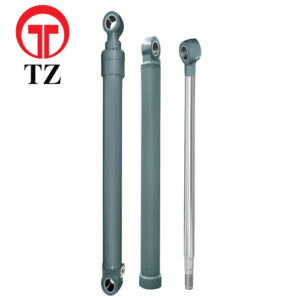To install and connect an excavator stick cylinder to the excavator, the following steps are typically followed:
Preparation: Ensure the excavator is properly positioned and stabilized on level ground. Engage the safety mechanisms and power off the engine.
Identify Mounting Points: Locate the mounting points on the excavator’s boom and stick where the stick cylinder will be attached. These mounting points are designed and positioned specifically for the cylinder installation.
Align the Cylinder: Position the stick cylinder in alignment with the mounting points on the boom and stick. Ensure that the cylinder is oriented correctly and securely in place before proceeding.
Secure Mounting Brackets: Attach the mounting brackets or ears of the stick cylinder to the corresponding mounting points on the boom and stick. Use appropriate bolts, pins, or other fasteners to secure the cylinder in place. Follow the manufacturer’s guidelines and torque specifications for proper installation.
Connect Hydraulic Hoses: Connect the hydraulic hoses from the excavator’s hydraulic system to the corresponding ports on the stick cylinder. Ensure the connections are tight and properly sealed to prevent fluid leakage. The hydraulic hoses are responsible for supplying hydraulic fluid to the cylinder for operation.
Test Connections: Conduct a visual inspection to verify that all connections, bolts, and fasteners are secure and properly aligned. Ensure there are no signs of leaks or loose fittings. Additionally, check the range of movement and operation of the cylinder to ensure it is functioning correctly.
Perform Functional Tests: Once the cylinder is installed and the connections are secure, test the functionality of the stick cylinder. Operate the excavator’s hydraulic controls to extend and retract the cylinder, verifying smooth and controlled movement without any abnormal sounds or vibrations.
Safety Checks: Before resuming regular operation, perform a thorough safety check of the excavator, including the installed stick cylinder. Verify that all connections, excavator stick cylinder suppliers bolts, and fasteners are secure, and that there are no signs of leaks or other potential issues. Ensure that the stick cylinder is properly aligned and functioning as intended.
It’s important to note that the specific installation process may vary depending on the make and model of the excavator and the type of stick cylinder being installed. Always refer to the manufacturer’s instructions and guidelines for proper installation procedures and safety precautions. If unsure, it’s recommended to consult with a qualified technician or the manufacturer for assistance.
What are the potential issues or common problems with excavator stick cylinders?
Excavator stick cylinders can experience several potential issues or common problems. Here are a few examples:
Leakage: One common problem with stick cylinders is hydraulic fluid leakage. This can occur due to worn seals, damaged piston rods, or faulty connections. Leakage reduces the effectiveness and efficiency of the cylinder and can lead to hydraulic system contamination.
Seal Wear: The seals in the stick cylinder can wear out over time due to constant movement and exposure to harsh conditions. Seal wear can result in hydraulic fluid leakage, reduced cylinder performance, and compromised functionality.
Bent or Damaged Rods: The piston rod of the stick cylinder can become bent or damaged, affecting the smooth operation of the cylinder. This can be caused by accidents, impacts, or excessive loads. Bent or damaged rods should be repaired or replaced promptly to avoid further damage.
Corrosion: Stick cylinders are often exposed to moisture, dirt, and other corrosive elements in construction environments. Over time, this exposure can lead to corrosion on the cylinder body, piston rod, or other components. Corrosion can impair cylinder performance and eventually cause failure if not addressed.
Cylinder Drift: Cylinder drift refers to the gradual movement or extension of the stick cylinder even when the hydraulic controls are not activated. It can be caused by internal leakage or worn components within the cylinder. Cylinder drift should be addressed as it affects the precision and control of the excavator’s operations.
Overloading: Exceeding the recommended load capacity or subjecting the stick cylinder to excessive forces can lead to damage or failure. Overloading can cause bent rods, seal failures, or even catastrophic cylinder failure. It’s essential to operate the excavator within the specified load limits to avoid such issues.
Contamination: Contaminants such as dirt, debris, or metal particles can enter the hydraulic system and affect the stick cylinder’s performance. Contamination can lead to increased wear, reduced efficiency, and damage to internal components. Regular fluid maintenance, including proper filtration and periodic fluid changes, helps minimize contamination-related issues.
Misalignment: Misalignment of the stick cylinder can occur due to improper installation, loose connections, or wear and tear. Misalignment can result in uneven forces, increased stress on components, and compromised operation. Regular inspections and maintenance can help identify and rectify misalignment issues.
It’s important to address any issues or problems with excavator stick cylinders promptly. Regular maintenance, inspections, and following proper operating procedures can help prevent or minimize these common problems and ensure the longevity and performance of the stick cylinder. Consulting with a qualified technician or contacting the manufacturer for guidance is recommended when troubleshooting or addressing specific issues.

